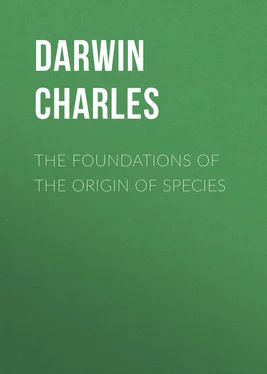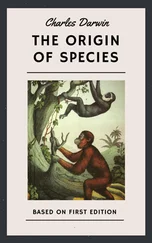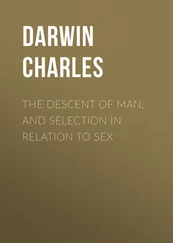Charles Darwin - The Foundations of the Origin of Species
Здесь есть возможность читать онлайн «Charles Darwin - The Foundations of the Origin of Species» — ознакомительный отрывок электронной книги совершенно бесплатно, а после прочтения отрывка купить полную версию. В некоторых случаях можно слушать аудио, скачать через торрент в формате fb2 и присутствует краткое содержание. Жанр: foreign_antique, foreign_prose, на английском языке. Описание произведения, (предисловие) а так же отзывы посетителей доступны на портале библиотеки ЛибКат.
- Название:The Foundations of the Origin of Species
- Автор:
- Жанр:
- Год:неизвестен
- ISBN:нет данных
- Рейтинг книги:3 / 5. Голосов: 1
-
Избранное:Добавить в избранное
- Отзывы:
-
Ваша оценка:
- 60
- 1
- 2
- 3
- 4
- 5
The Foundations of the Origin of Species: краткое содержание, описание и аннотация
Предлагаем к чтению аннотацию, описание, краткое содержание или предисловие (зависит от того, что написал сам автор книги «The Foundations of the Origin of Species»). Если вы не нашли необходимую информацию о книге — напишите в комментариях, мы постараемся отыскать её.
The Foundations of the Origin of Species — читать онлайн ознакомительный отрывок
Ниже представлен текст книги, разбитый по страницам. Система сохранения места последней прочитанной страницы, позволяет с удобством читать онлайн бесплатно книгу «The Foundations of the Origin of Species», без необходимости каждый раз заново искать на чём Вы остановились. Поставьте закладку, и сможете в любой момент перейти на страницу, на которой закончили чтение.
Интервал:
Закладка:
150
See Origin , Ed. i. p. 437, vi. p. 599.
151
The following passage seems to have been meant to precede the sentence beginning “These facts”: – “It is evident, that when in each individual species, organs are metamorph. a unity of type extends.”
152
This is, I believe, the first place in which the author uses the words “theory of descent.”
153
The sentence should probably run, “Let us take the case of the vertebrata: if we assume them to be descended from one parent, then by this theory they have been altered &c.”
154
That is “we should call it a morphological fact.”
155
In the Origin , Ed. i. p. 438, vi. p. 602, the author, referring to the expressions used by naturalists in regard to morphology and metamorphosis, says “On my view these terms may be used literally.”
156
See Origin , Ed. i. p. 439, vi. p. 605.
157
In the Origin , Ed. i. p. 440, vi. p. 606, the author argues that the “loop-like course of the arteries” in the vertebrate embryo has no direct relation to the conditions of existence.
158
The following passages are written across the page: – “They pass through the same phases, but some, generally called the higher groups, are further metamorphosed.
? Degradation and complication? no tendency to perfection.
? Justly argued against Lamarck?”
159
An almost identical passage occurs in the Origin , Ed. i. p. 440, vi. p. 606.
160
The following: “Deaths of brothers «when» old by same peculiar disease” which is written between the lines seems to have been a memorandum which is expanded a few lines lower. I believe the case of the brothers came from Dr R. W. Darwin.
161
See the discussion to this effect in the Origin , Ed. i. pp. 443-4, vi. p. 610. The author there makes the distinction between a cause affecting the germ-cell and the reaction occurring at a late period of life.
162
Possibly the sentence was meant to end “is not visible till then.”
163
See Origin , Ed. i. pp. 444-5, vi. p. 611. The query appended to much less is justified, since measurement was necessary to prove that the greyhound and bulldog puppies had not nearly acquired “their full amount of proportional difference.”
164
«The following discussion, from the back of the page, is in large measure the same as the text.» I think light can be thrown on these facts. From the following peculiarities being hereditary, [we know that some change in the germinal vesicle is effected, which will only betray itself years after] diseases – man, goitre, gout, baldness, fatness, size, [longevity «illegible» time of reproduction, shape of horns, case of old brothers dying of same disease]. And we know that the germinal vesicle must have been affected, though no effect is apparent or can be apparent till years afterwards, – no more apparent than when these peculiarities appear by the exposure of the full-grown individual. «That is, “the young individual is as apparently free from the hereditary changes which will appear later, as the young is actually free from the changes produced by exposure to certain conditions in adult life.”» So that when we see a variety in cattle, even if the variety be due to act of reproduction, we cannot feel sure at what period this change became apparent. It may have been effected during early age of free life «or» fœtal existence, as monsters show. From arguments before used, and crossing, we may generally suspect in germ; but I repeat it does not follow, that the change should be apparent till life fully developed; any more than fatness depending on heredity should be apparent during early childhood, still less during fœtal existence. In case of horns of cattle, which when inherited must depend on germinal vesicle, obviously no effect till cattle full-grown. Practically it would appear that the [hereditary] peculiarities characterising our domestic races, therefore resulting from vesicle, do not appear with their full characters in very early states; thus though two breeds of cows have calves different, they are not so different, – grey-hound and bull-dog. And this is what is «to» be expected, for man is indifferent to characters of young animals and hence would select those full-grown animals which possessed the desirable characteristics. So that from mere chance we might expect that some of the characters would be such only as became fully apparent in mature life. Furthermore we may suspect it to be a law, that at whatever time a new character appears, whether from vesicle, or effects of external conditions, it would appear at corresponding time «see Origin , Ed. i. p. 444». Thus diseases appearing in old age produce children with do., – early maturity, – longevity, – old men, brothers, of same disease – young children of do. I said men do not select for quality of young, – calf with big bullocks. Silk-worms, peculiarities which, appear in caterpillar state or cocoon state, are transmitted to corresponding states. The effect of this would be that if some peculiarity was born in a young animal, but never exercised, it might be inherited in young animal; but if exercised that part of structure would be increased and would be inherited in corresponding time of life after such training.
I have said that man selects in full-life, so would it be in Nature. In struggle of existence, it matters nothing to a feline animal, whether kitten eminently feline, as long as it sucks. Therefore natural selection would act equally well on character which was fully «developed» only in full age. Selection could tend to alter no character in fœtus, (except relation to mother) it would alter less in young state (putting on one side larva condition) but alter every part in full-grown condition. Look to a fœtus and its parent, and again after ages fœtus and its «i. e. the above mentioned parents» descendant; the parent more variable «?» than fœtus, which explains all.
165
Some of these examples occur in Origin , Ed. i. pp. 450-51, vi. pp. 619-20.
166
The two following sentences are written, one down the margin, the other across the page. “Abortive organs eminently useful in classification. Embryonic state of organs. Rudiments of organs.”
167
I imagine the meaning to be that abortive organs are specific characters in contrast to monstrosities.
168
Minute hanging horns are mentioned in the Origin , Ed. i. p. 454, vi. p. 625, as occurring in hornless breeds of cattle.
169
Linum flavum is dimorphic: thyme gynodiæcious. It is not clear what point is referred to under Geranium pyrenaicum .
170
The author’s work on duck’s wings &c. is in Var. under Dom. , Ed. 2, i. p. 299.
171
The words vis medicatrix are inserted after “useless,” apparently as a memorandum.
172
In the male florets of certain Compositæ the style functions merely as a piston for forcing out the pollen.
173
«On the back of the page is the following.» If abortive organs are a trace preserved by hereditary tendency, of organ in ancestor of use, we can at once see why important in natural classification, also why more plain in young animal because, as in last section, the selection has altered the old animal most. I repeat, these wondrous facts, of parts created for no use in past and present time, all can by my theory receive simple explanation; or they receive none and we must be content with some such empty metaphor, as that of De Candolle, who compares creation to a well covered table, and says abortive organs may be compared to the dishes (some should be empty) placed symmetrically!
Читать дальшеИнтервал:
Закладка:
Похожие книги на «The Foundations of the Origin of Species»
Представляем Вашему вниманию похожие книги на «The Foundations of the Origin of Species» списком для выбора. Мы отобрали схожую по названию и смыслу литературу в надежде предоставить читателям больше вариантов отыскать новые, интересные, ещё непрочитанные произведения.
Обсуждение, отзывы о книге «The Foundations of the Origin of Species» и просто собственные мнения читателей. Оставьте ваши комментарии, напишите, что Вы думаете о произведении, его смысле или главных героях. Укажите что конкретно понравилось, а что нет, и почему Вы так считаете.












